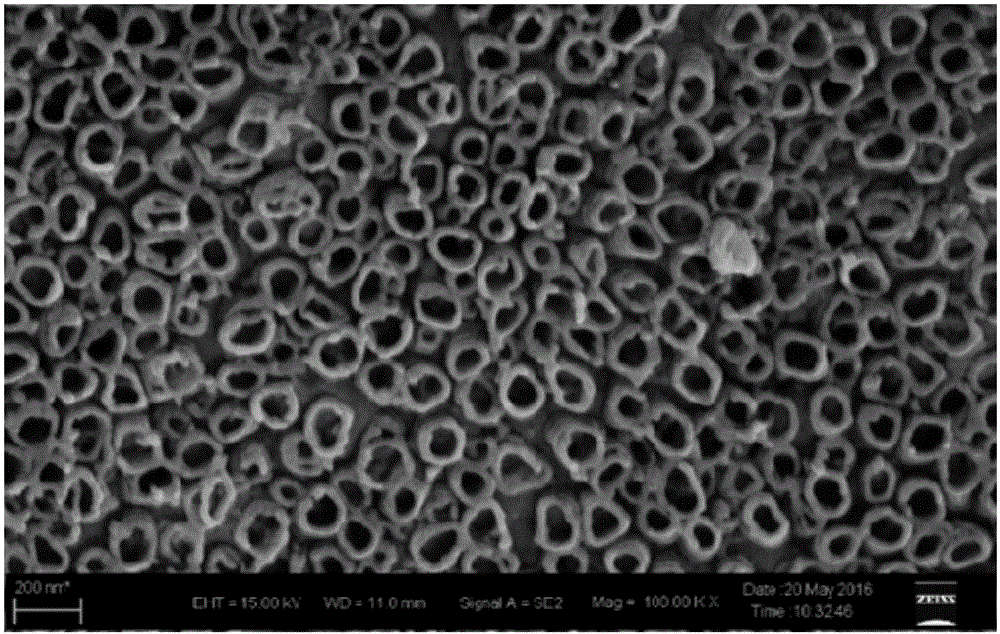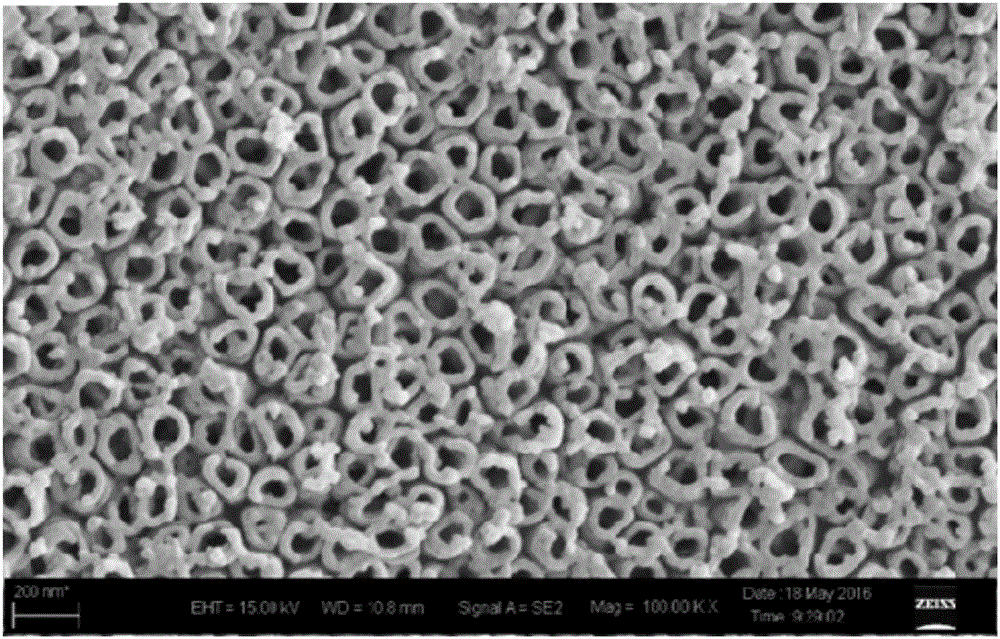Method for preparing titanium oxide nanotube/carbon/manganese oxide composite material by employing electrochemical reduction method
A technology of titanium oxide nanotubes and composite materials, which is applied in the field of preparing supercapacitor composite materials, can solve the problems of small capacitor capacity, achieve the effects of reducing resistance, high capacitance performance, and increasing electric double layer capacitance
- Summary
- Abstract
- Description
- Claims
- Application Information
AI Technical Summary
Problems solved by technology
Method used
Image
Examples
specific Embodiment approach 1
[0027] Specific embodiment one: this embodiment is a kind of method that utilizes electrochemical reduction method to prepare titanium oxide nanotube / carbon / manganese oxide composite material and is finished according to the following steps:
[0028] A three-electrode system is composed of titanium oxide nanotubes loaded with carbon on the surface, Pt electrode and saturated calomel electrode. Potassium permanganate solution of 0.02mol / L~0.1mol / L; CHI660D electrochemical workstation was used to conduct chemical deposition by constant potential deposition method to obtain titanium oxide nanotube / carbon / manganese oxide composite material;
[0029] The low voltage of the constant potential deposition method is -0.10V~-0.20V, the high voltage is 0.7V~0.9V, the scanning rate is 20mV / s~200mV / s, and the number of cycles is 10~500 times.
[0030] The principle of this implementation mode:
[0031] 1. In this embodiment, carbon is loaded on the titanium dioxide nanotubes, which can re...
specific Embodiment approach 2
[0036]Embodiment 2: The difference between this embodiment and Embodiment 1 is that the titanium oxide nanotubes with carbon on the surface are completed according to the following steps:
[0037] 1. Preparation of titanium dioxide nanotubes by anodic oxidation method:
[0038] ①. Use 120#SiC sandpaper, 1000#SiC sandpaper and 2000#SiC sandpaper to polish the titanium sheet in sequence to obtain a titanium sheet with a bright surface;
[0039] ②. Use absolute ethanol and acetone to clean the titanium sheet with bright surface for 3 to 5 times respectively to obtain the treated titanium sheet;
[0040] 2. Add the electrolyte solution into the inorganic glass electrolytic cell, connect the treated titanium sheet to the positive pole of the power supply as the anode, and connect the copper sheet to the negative pole of the power supply as the cathode; use a DC power supply for power supply at a voltage of 18V React at ~22V for 80min~100min, take out the reacted titanium sheet;
...
specific Embodiment approach 3
[0046] Embodiment 3: The difference between this embodiment and Embodiment 1 or 2 is: the low voltage of the constant potential deposition method is -0.15V, the high voltage is 0.8V, and the scan rate is 20mV / s~100mV / s, the number of cycles is 100 to 300 times. Other steps are the same as those in Embodiment 1 or 2.
PUM
 Login to View More
Login to View More Abstract
Description
Claims
Application Information
 Login to View More
Login to View More - R&D
- Intellectual Property
- Life Sciences
- Materials
- Tech Scout
- Unparalleled Data Quality
- Higher Quality Content
- 60% Fewer Hallucinations
Browse by: Latest US Patents, China's latest patents, Technical Efficacy Thesaurus, Application Domain, Technology Topic, Popular Technical Reports.
© 2025 PatSnap. All rights reserved.Legal|Privacy policy|Modern Slavery Act Transparency Statement|Sitemap|About US| Contact US: help@patsnap.com



